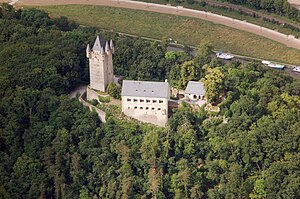Nassau Castle
| Nassau Castle | ||
|---|---|---|
|
Aerial photograph 2007 |
||
| Creation time : | before 1100 | |
| Castle type : | Höhenburg, summit location | |
| Conservation status: | partially restored ruin | |
| Standing position : | Count | |
| Place: | Nassau | |
| Geographical location | 50 ° 18 '39.2 " N , 7 ° 47' 32.2" E | |
| Height: | 215.4 m above sea level NHN | |
|
|
||
The ruins of Nassau Castle rise near the town of the same name, Nassau, at 215.4 m above sea level. NHN high Burgberg , a rock cone 120 meters above the Lahn in the Rhineland-Palatinate Rhein-Lahn district and is a typical example of a summit castle . Its builders came from the House of Nassau , which is still the rulers of the Netherlands and Luxembourg today .
history
Nassau Castle was first mentioned in 1093 when Count Dudo von Laurenburg was mentioned in the first deed of foundation of Laach Abbey . Since the document is considered a forgery in circles of historians, this year is not a reliable indication. The castle's guaranteed beginnings date back to around the year 1100. In 1120 Ruprecht I von Laurenburg (also Rupert I) and his brother Arnold I took possession of the Nassau castle hill and the residential tower on it. They had the castle complex redesigned and expanded in 1124.
However, as the castle was on the land of the diocese of Worms at the time, the two brothers' taking possession of them led to a bitter dispute between their family and the cathedral monastery of Worms , which was only settled by Fallemanien in 1159 through the intervention of Archbishop Hillin of Trier could. The Laurenburg count family renounced their allodial rights and in return was enfeoffed by the archbishop with castle and rule Nassau. From then on, the Laurenburgers called themselves "Counts of Nassau" after their new family seat. This happens for the first time in 1160 with Heinrich I of Nassau.
Whose cousin Henry II. - Heinrich the Rich called - was in the period 1220-1230 a palace in the style of late Romanesque built.
1255 it came to the so-called brother division, which in the course of which county of Nassau between Henry sons Walram II. And Otto I was divided. Nassau Castle, however, remained in the joint ownership of the two brothers and thus became the Ganerbeburg .
In the first half of the 14th century the now rebuilt 33 meter high pentagonal keep was built. A second castle tower was also mentioned in 1346, but it no longer exists today. During a family feud between Ruprecht the Quarreling from Nassau-Sonnenberg , from the Walram line of the house, and Johann I von Nassau-Dillenburg , the senior of the Ottonian line, the Burgmannen houses that were evidently once existing were destroyed in 1372 .
Nassau Castle was inhabited until the end of the Middle Ages , but was then abandoned as the residence of the counts. This started the gradual decline of the facility.
An engraving by Matthäus Merian from the 17th century shows an intact hall and keep as well as a gatehouse , but the remaining ruins were destroyed in the final phase of the Second World War . When in 1970 work began to uncover the rectangular castle ring, there was hardly anything left of the structure.
From 1976 carried out restoration of the keep: its hipped roof and battlements , and its bevy watch towers were rebuilt after the engraving by Merian and the six to eight meter high arcades arch its interiors decorated. In addition, the opening to the dungeon in the basement of the tower was uncovered.
The rebuilding of the palace and its knight's hall followed from 1979 to 1980, during which late Gothic window arcades were rediscovered.
Nassau Castle came into the possession of the State Palace Administration of Rhineland-Palatinate (today castles, palaces, antiquities of Rhineland-Palatinate ).
Todays use
The keep can be visited from April to October. The stair tower built on the east side leads to a circumferential viewing gallery , which offers a good view of Nassau and the surrounding area. The registry office of the city of Nassau has a wedding room on the third floor of the keep. The Palas now houses a restaurant.
literature
- Ferdinand Luthmer : The architectural and art monuments of the Lahn area: Oberlahnkreis, Limburg district, Unterlahnkreis . Keller, Frankfurt am Main 1907, p. 200 ff. ( Digitized version ).
- Magnus Backes (arrangement): State castles, palaces and antiquities in Rhineland-Palatinate . 6th edition. Mainz 1997, p.
- Alexander Thon, Stefan Ulrich, Jens Friedhoff : "Decided with strong iron chains and bolts ...". Castles on the Lahn . Schnell & Steiner, Regensburg 2008, ISBN 978-3-7954-2000-0 , pp. 124-129.
Web links
- Entry on Nassau Castle in the scientific database " EBIDAT " of the European Castle Institute
- Nassau Castle on burgenarchiv.de
Individual evidence
- ↑ Map service of the landscape information system of the Rhineland-Palatinate Nature Conservation Administration (LANIS map) ( notes ) Scale 1: 1,000





